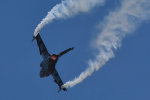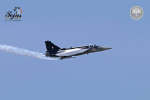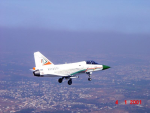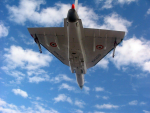LCA Tejas Mk1 & Mk1A - News and discussions
- Thread starter Ashwin
- Start date
-
- Tags
- indian defence forum
Ajay Shukla articles on IAF or aviation matters, should be taken with caution, by the lack of his knowledge in these areas. The fact that he thinks Su 30 MKMs have Israeli content like MKIs and that that would be an advantage shows that very well.
Tejas flies on L&T wings as HAL completes production of last IOC fighter
Bengaluru: The last Light Combat Aircraft Tejas Mk1 fighter from the Initial Operational Clearance (IOC) block has flown out of the hangars of Hindustan Aeronautics Limited (HAL).
And most significantly, it (SP-16; SP stands for Series Production) flew on the wings made by Larson & Tourbo (L&T). This is a major step in HAL’s efforts to outsource Tejas parts to the private industries, in line with the Make in India mandate.
Engineers in HAL familiar with the Tejas Mk1 production confirmed to Onmanorma that the L&T wings came to LCA Division in January this year.

Tejas SP-16, which first flew on March 11, lands. Photo: HAL
“The full structure (both left and right wings) came from L&T and our teams completed the wiring and pipeline work within two months. This is a significant development in Tejas production,” an official said. Tejas SP-16 first flew on March 11 while SP-15 on March 22.
HAL has installed the looms supplied by its subsidiary Naini Aerospace on SP-15 and SP-16. The assembly cycle time has been reduced considerably, thanks to TATA-HAL sub-assembly tools.
Full quota of fighters
The Indian Air Force’s (IAF) No 45 Squadron, Flying Daggers, based at AFS Sulur has so far 12 Tejas fighters operating under its command. It will now add another four more to the fleet after completing the CAF (customer acceptance flights).

Tejas SP 15 takes off. Photo: HAL
The Flying Daggers are expected to have the full quota of 16 IOC Tejas Mk1 fighters within a month.
Two of the Squadron fighters are now at Langkawi in Malaysia participating in the Langkawi International Maritime Aero Expo (LIMA-2019) set to begin on March 26.
HAL on Monday said that it has rolled out the 16th LCA as per the target till March 31, 2019.’
As this piece goes live, the SP-13 awaits one more CAF before being signalled out to AFS Sulur by IAF. SP-14 has completed all CAF flights and is awaiting IAF pilots to take it to Sulur.
Normally, a Tejas Mk1 undergoes three test-flights undertaken by HAL’s Test Pilots followed by another three CAF by the IAF pilots. The CAF flight could be undertaken by pilots from Flying Daggers or those from the Aircraft and Systems Testing Establishment of IAF.

The Tejas SP 15 first flew on March 22.
Onmanorama had reported extensively in November last about HAL plans to ramp up the production facilities.
The TD (technology development) phase for LCA project was sanctioned in 1993 and only after the first flight of TD-1 in 2001 (proving the technologies), the LCA programme was sanctioned. The first Tejas was inducted into the IAF in July 2016.
Augmented production
Tejas Mk1 was given FOC on February 20, 2019 at Air Force Station Yelahanka, during the 12th edition of Aero India.
HAL began preparations for producing the next version of Tejas fighters towards the end of last year. The provisional DAL (Drawing Applicability List) for FOC fighters was released in October 2017 and the amended one in August 2018. (DAL is the standard of preparation for production that forms the basis for the final product to be delivered to the customer.)

SP-14 has completed all CAF flights and is awaiting IAF pilots to take it to Sulur. Photo: HAL
To augment Tejas production, HAL established a second production line at its Aircraft Division which has been carrying out structural assembly, final assembly and equipping of the aircraft.
Out of the 16 Tejas Mk-1 IOC fighters SP-5, SP-8, SP-11 SP-13 and SP-15 were produced by the Aircraft Division. The load of producing the next 16 FOC block fighters too will be shared by HAL’s LCA and Aircraft Divisions.
As on today, four assembly structures are loaded with FOC components. Two real fuselages (SP-21 and SP-22) have been removed from the assembly jig and ready for loading to the coupling jig.
FOC fighters
The front fuselage of SP-21 is in the advance stages with the mid-air refuelling probe requirement installed on it. The central fuselage too is in an advance stage and all the three fuselages are expected to be ready by end of April this year.
HAL now says SP-21 will roll out by the end of this year. The entire 16 FOC fighters will be delivered to IAF during 2019-2021 – which again accounts for eight aircraft per year.
View attachment 5475
The SP-13 awaits one more CAF before being signalled out to AFS Sulur. Photo: HAL
For the record, HAL delivered one Tejas in 2015-16; two in 2016-17; five in 2017-18 aircraft and eight in 2018-19 (subject to acceptance of last four fighters).
HAL says the build-standard of eight FOC trainers should be ready by next month. The first FOC trainer is expected to fly out towards the end of 2021.
HAL has now confirmed orders of 32 Tejas Mk-1 fighters (16 IOC & 16 FOC) and eight FOC trainers.
IAF Chief Air Chief Marshal B S Dhanoa has said during Aero India 2019 that the process of issuing RFP (request for proposal) for 83 Tejas MK1As (the advance variant) is in advance stages.
(The writer is an independent aerospace and defence journalist, who blogs at Tarmak007 and tweets @writetake.)
Should be bookmarked by everyone, good summery of data.
on that note:Ajay Shukla articles on IAF or aviation matters, should be taken with caution, by the lack of his knowledge in these areas. The fact that he thinks Su 30 MKMs have Israeli content like MKIs and that that would be an advantage shows that very well.
As Malaysia does not recognise nor have diplomatic relations with the state of Israel,[14] Malaysian passports bear the inscription: "This passport is valid for all countries except Israel". Israeli passport holders are not permitted to enter Malaysia without written permission from the Malaysian Ministry of Home Affairs.
someone should tell him about this so he doesnt make a fool of himself.
on topic, Malaysian SU 30s have south african sensors.. possibly HAL can accomodate any kind of sensor package that Malaysians choose. dont forget, Su MKM of Malaysia is based on Su MKI of India and HAL makes some parts for Malaysian Su 30 MKMs
ok I have to say this. despite all the slip ups in the LCA program, it looks to be coming of age and making us proud. What are the chances of winning the Malaysian order? given
1) HAL already builds some parts of Malaysian MKM,
2) HAL (as opposed to the Chengdu CAC's JF-17) can incorporate any 3rd party components (JF-17 cannot incorporate western components a BIG plus)
3) HAL probably does not have the track record of Chinese manufacturers in terms of after sales support (but see point #1)
in some of my more colorful imaginations - I would like to include Malaysia as a partner for LCA manufacturing (or even space based tech) - increase influence in the region and be connected with the ASEAN members. (they paid Billions to Russia in their Su 30 MKM project just to have a Malaysian astronaut go to space).
1) HAL already builds some parts of Malaysian MKM,
2) HAL (as opposed to the Chengdu CAC's JF-17) can incorporate any 3rd party components (JF-17 cannot incorporate western components a BIG plus)
3) HAL probably does not have the track record of Chinese manufacturers in terms of after sales support (but see point #1)
in some of my more colorful imaginations - I would like to include Malaysia as a partner for LCA manufacturing (or even space based tech) - increase influence in the region and be connected with the ASEAN members. (they paid Billions to Russia in their Su 30 MKM project just to have a Malaysian astronaut go to space).
ok I have to say this. despite all the slip ups in the LCA program, it looks to be coming of age and making us proud. What are the chances of winning the Malaysian order?
"the government to strengthen internal counter-insurgency capabilities instead of external territorial defence.
The newer emphasis has prompted the emergence of the RMAF's LCA procurement even if this programme also faces financial hurdles...
...RMAF officials have stressed to Jane's the need for a light and flexible fighter aircraft that can be used in ground attack and counter-insurgency operations, with a capability to take off and land on short runways"
LIMA 2019: Saab promotes ‘one platform’ approach to meet Malaysia’s air combat needs | Jane's 360
@Milspec personally I think, HAL should offer armed HAWK, which might have better chances than Tejas. Costs, BAE support, shouldn't have many Israeli parts either and they already have older versions AFAIK, so commonality benefits too.
I am not too keen with Malaysia's competition, I personally do not think the product has matured to be exported, and more importantly to be commercially viable bid, most likely HAL will have to offer it at a price that is lower than it's cost. I have no interest is HAL positioning itself in a bottom line nightmare, especially when this MoD is hellbent on destroying HAL through other means.@Milspec personally I think, HAL should offer armed HAWK, which might have better chances than Tejas. Costs, BAE support, shouldn't have many Israeli parts either and they already have older versions AFAIK, so commonality benefits too.
Same is the issue with Combat Hawks, they have had next to nothing when it comes to indigenisation, most of the parts for it are off the shelf items, engine and ancillary components are overpriced and BAE's attitude is "Douche'y" for the lack of a better term.
From HAL's perspective, once LCA's line matures, they will start taking cost out of it, and it will become a high margin line. At that point, I really dont care about export orders as our internal market is more than enough to make up for volumes. Like as of now, ALH has one of the highest margins for HAL.
HAL's unfortunately does not have a good Product support and Marketing division, because the real gem in it's lineup is the ALH family with the Dhruv, ALH WSO Rudra, and the LCH. All three of these are exceptional systems, reliability proven through it's service, and have good export opportunity. They also present ample indigenisation opportunity of weapons systems like the 20mm auto cannon (Which can have multi platform application), rocket pods, and Helina/Mistral.
Last edited:
#TejasUpdate
— Indian Defence (@IndianDefenceRA) March 29, 2019
According to reports #Malaysia sends RFI to manufacturers of Yak-130, Tejas, JF-17, MB-339 and T-50 for their light fighter procurement : to procure 18 jets with option of 18 more.
(Photo courtesy: @airforcenextgen) pic.twitter.com/OQZ0DuIX2a


Indigenously developed LCA-Tejas aircraft is leaving the audience spellbound at Langkawi, Malaysia.
— Indian Air Force (@IAF_MCC) March 29, 2019
Here's the display visuals of Tejas from #LIMA2019. The aircraft is keeping the aviation enthusiasts glued to the sky. Jai Hind!@DefenceMinIndia @SpokespersonMoD @LimaExhibition pic.twitter.com/8pJ6llwqi8
#LIMA2019 : The RMAF Chief, General Tan Sri Dato' Sri Hj Affendi Buang, visited all the participating contingents of LIMA at Langkawi, Malaysia on 29 Mar 19.
— Indian Air Force (@IAF_MCC) March 30, 2019
He interacted with the team IAF members & exchanged mementos. pic.twitter.com/Dozzx1lBjX


























